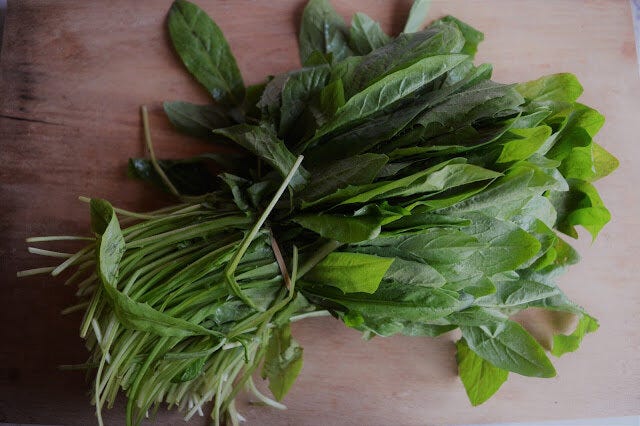In cooler months, the kitchen at the American Academy in Rome receives boxes upon boxes of cicoria selvatica from local farmers, and the cooks spend hours sifting through it, removing woody stems and rinsing it of grit. Cicoria selvatica translates to wild chicory, or Italian dandelion greens, and it thrives in The Eternal City. Once you know what to look for — its long, green leaves and delicate, pale purple flowers — you see it everywhere: along the sides of the road, in parks, and of course on the menus of almost every Roman restaurant. When raw, the greens are bitter and almost spicy, but when cooked, their flavor mellows: still bitter but with a gentle sweetness, too.

Cleaning cicoria is a labor of love, which I learned upon arriving at the Academy last February to cook with the Rome Sustainable Food Project (RSFP). Cicoria arrived in windfalls — a wild, tangled thing — and taming it took a not-insignificant amount of time. I would’ve likely found the task tedious had I not fallen fast and hard for the traditional Roman preparation of cicoria known as cicoria ripassata, which is how we cooked it almost every time. Ripassata refers to the technique of boiling something until tender, draining it, then cooking it again in a skillet with olive oil, garlic, and chili flakes. Ripassata means passed again, or cooked again, and works well with all sorts of vegetables, including (but not limited to!) broccoli and beet greens and broccoli rabe. I ate so much cicoria ripassata, and ripassata of all sorts, over my six months in Rome that it’s a miracle I didn’t turn green.
In Rome, ripassata is a given: a standard, old-school technique employed in their daily cooking. Romans generally like their hardy greens long-cooked, tender, and glossy with olive oil — a lesson I learned from the RSFP sous chef, Sara, an Italian-American who’s lived in Italy for most of her life. Every day we’d serve two separate lunches, and the first one would be for the almost exclusively Italian staff members. Their collective taste was resolutely traditional, and they never tired of the Roman classics. Although we laughed about it in the kitchen and jokingly threatened to add unfamiliar spices to their lunches, I appreciated the education in Roman grandma-style cuisine.
At the end of the day what I most love to eat is the simplest things: greens, garlic, chili flakes, olive oil. Sara once told me that her perfect lunch is cicoria ripassata, good mozzarella, and bread to sop up any olive oil that remains on the plate. Is that not the most beautiful thing you’ve ever heard?
I haven’t managed to find wild chicory in New York, but I can often find high-quality broccoli rabe (broccoletti in Italian) at farmers markets and grocery stores. It is not the same thing, but it gives my palate the bitter satisfaction it so often craves.
Broccoletti ripassati / Twice-cooked broccoli rabe
Ingredients
Kosher salt
1 lb broccoli rabe, cleaned and trimmed of woody ends
A healthy glug of olive oil (about ¼ cup)
3 cloves of garlic (or as many as your heart desires), thinly sliced
Generous pinch of chili flakes
Steps
Bring a large pot of salted water to a boil. The water should be *quite* salty in order to infuse the greens with flavor.
Add broccoli rabe to the boiling water and cook for about 4 minutes, or until a fork easily pierces the thickest part of the stem.
Drain the broccoli rabe in a colander, and when cool enough to handle, squeeze it in a dishcloth to remove excess moisture. If desired, chop the broccoli rabe into more manageable pieces.
In a large skillet, heat olive oil with garlic over medium heat until the garlic turns lightly golden. Add chili flakes and cook briefly (~15 seconds) before adding broccoli rabe.
Cook broccoli rabe in the garlic-chili oil over medium heat, tossing frequently, until very tender and flavorful (roughly 10 minutes). Season with salt and serve! I like to add lemon zest, too, although it’s untraditional.
Ideas for eating broccoletti ripassati:
With mozzarella and bread à la Sara
With pasta, sweet Italian sausage, and Pecorino Romano
As the sole ingredient in a sandwich of pizza bianca or focaccia or another delicious bread
On its own in a bowl with a fork
Welcome to the most delicious way to eat your greens, especially in the winter.
Love you all.
Phoebe






And I did almost the same with broccolini this evening. Hmmmm. Wonder if our palates are related?
Well, I made regular broccoli in this fashion this very evening -- and it was delicious. Thank you for the encouragement and inspiration. Would love to find some fresh chicory. Wonder if it will grow in VT? xoxo